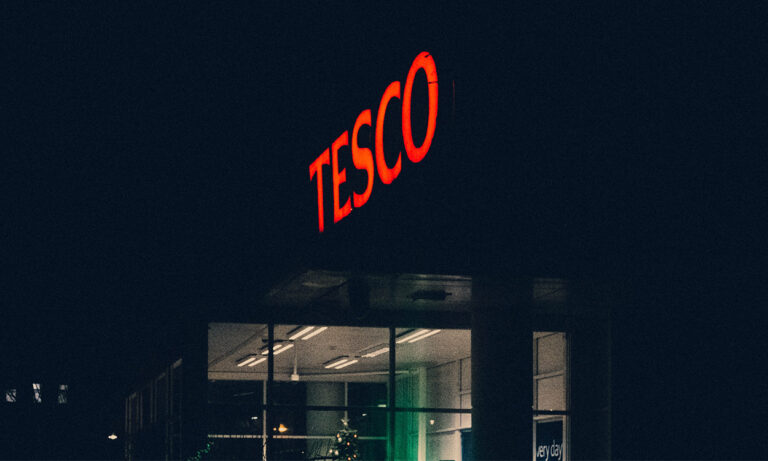Supermarket giant Tesco joins SHEIN in long list of companies exposed for workers mistreatment
Another one bites the dust. In what feels like a never-ending conveyor belt, British multinational groceries and general merchandise retailer Tesco has now joined an inexhaustible list of companies who’ve been exposed for their mistreatment of workers.
A recent report has revealed that over the course of three years, Burmese workers who produced F&F jeans for the supermarket giant in Thailand had been trapped in effective forced labour. This new evidence should ensure Tesco’s fast track inclusion into an emerging club of fashion swindlers—we’re talking about the likes of SHEIN, H&M and Primark.
The recent report, published by The Guardian, examined the treatment and conditions of workers producing garments for the Tesco Thailand brand from 2017 to 2020. Specifically, the labourers in question were making jeans, denim jackets and other clothing for the supermarket’s fashion range, F&F. The particular garment factory under observation was the VK Garment Factory (VKG) in Thailand.
After interviewing 21 employees, the investigation uncovered that most workers were being paid as little as £3 a day to work from 8 am to 11 pm. Often, employees would be forced to work through the night for up to 24 hours. Some individuals also reported that they’d be repeatedly verbally abused and threatened.
Moreover, The Guardian’s report emphasised the ways in which companies use workers’ immigration status as a form of manipulation and blackmailing. For example, it was revealed that a majority of the factory’s employees relied on VKG for their status and their immigration documents were almost always held within the factory building. In addition, more than a dozen of the people interviewed said the factory opened bank accounts for them and then confiscated the cards and passwords so they could make it appear they were paid minimum wage while paying much less in cash.
Workplace abuse often festers in environments where the majority of employees are immigrants. According to Forbes, more often than not employers will take advantage of undocumented workers’ precarious status, subjecting them to illegal workplace conduct such as discrimination or retaliation.
The lack of protection for immigrant workers is a global issue, and it appears that the fashion industry may be one of the most insidious offenders. Fast fashion brand SHEIN has repeatedly tried to defend itself against a slew of horrifying truths regarding its ethical and environmental impacts. Most recently, Channel 4 released a vilifying documentary aptly titled Untold: Inside the Shein Machine, wherein a spotlight was placed upon the Chinese company’s unacceptable working conditions and labour practices.
However, in a horrifying update, SHEIN was also recently revealed to be the most popular global fashion brand of 2022. Will someone please explain to me how this is possible? Despite having repeatedly condemned the fast fashion industry for its negligence—both in respect to its workers rights and its impact on driving overconsumption—the machine is showing no signs of coming to a halt.
Some have queried if the brand’s continued popularity might speak to the ramifications of the current cost of living crisis. It can’t be denied that SHEIN’s prices are incredibly low. However, there’s a seedy reason why.
Circling back to the Tesco ordeal, the supermarket conglomerate will now face a landmark lawsuit in the UK from 130 former workers who are suing the company for alleged negligence and unjust enrichment. In response, Tesco has alleged that the garments were sold only on the Thai market, though it’s been reported that there have been sightings of images with labels written in English on clothes understood to be made there.
While Tesco has stated that its primary focus has always been to protect the rights of those working within the supply chain, a number of experts within the report claimed that the company would have been aware of any red flags after conducting inspections. According to The Guardian’s investigation, this will be the first time a UK company has been threatened with litigation in the English courts over a foreign garment factory in its supply chain that it does not directly own.
It’s also a widely circulated sinister rule of thumb that big fashion brands such as F&F outsource the production of clothes so as to avoid liability and reputational damage. However, in this case, Tesco hopefully won’t be able to dodge accountability so easily.
This is also not the first time that Tesco has faced murky waters in regard to employee pay disputes. In 2021, thousands of current and former employees—primarily women—won a legal battle against the supermarket, having argued that they failed to receive equal pay for work of equal value with colleagues in its distribution centres who are mostly men. The European Court of Justice ruled in favour of the workers.
While it would be naive to expect the fashion industry to turn ethical overnight, this recent lawsuit is an important continuation of a fight to expose and hold to account the companies which consider themselves above the law. And maybe next time you’re fancying a muffin or packet of Wotsits, head elsewhere.






